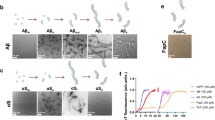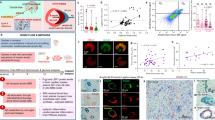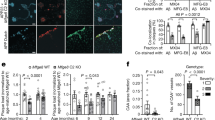Abstract
Amyloid-β peptide (Aβ) interacts with the vasculature to influence Aβ levels in the brain and cerebral blood flow, providing a means of amplifying the Aβ-induced cellular stress underlying neuronal dysfunction and dementia. Systemic Aβ infusion and studies in genetically manipulated mice show that Aβ interaction with receptor for advanced glycation end products (RAGE)-bearing cells in the vessel wall results in transport of Aβ across the blood-brain barrier (BBB) and expression of proinflammatory cytokines and endothelin-1 (ET-1), the latter mediating Aβ-induced vasoconstriction. Inhibition of RAGE-ligand interaction suppresses accumulation of Aβ in brain parenchyma in a mouse transgenic model. These findings suggest that vascular RAGE is a target for inhibiting pathogenic consequences of Aβ-vascular interactions, including development of cerebral amyloidosis.
This is a preview of subscription content, access via your institution
Access options
Subscribe to this journal
Receive 12 print issues and online access
$209.00 per year
only $17.42 per issue
Buy this article
- Purchase on Springer Link
- Instant access to full article PDF
Prices may be subject to local taxes which are calculated during checkout






Similar content being viewed by others
References
Selkoe, D.J. Clearing the brain's amyloid cobwebs. Neuron 32, 177–180 (2001).
Yan, S.D. et al. RAGE and amyloid-β peptide neurotoxicity in Alzheimer's disease. Nature 382, 685–691 (1996).
Thomas, T., Thomas, G., McLendo, C., Sutton, T. & Mullan, M. β-amyloid-mediated vasoactivity and vascular endothelial damage. Nature 380, 115–118 (1996).
Shibata, M. et al. Clearance of Alzheimer's amyloid-β1–40 peptide from brain by low-density lipoprotein receptor-related protein-1 at the blood brain barrier J. Clin. Invest. 106, 1489–1499 (2000).
Zlokovic, B.V. et al. Clearance of amyloid-β-peptide from brain: transport or metabolism? Nat. Med. 6, 718–719 (2000).
Bading, J.R. et al. Brain clearance of Alzheimer's amyloid-β40 in the squirrel monkey: a SPECT study in a primate model of cerebral amyloid angiopathy. J. Drug Targeting 10, 359–368 (2002).
DeMattos, R.B. et al. Brain to plasma amyloid-β efflux: a measure of brain amyloid burden in a mouse model of Alzheimer's disease. Science 295, 2264–2267 (2002).
DeMattos, R.B. et al. Plaque-associated disruption of CSF and plasma amyloid-β equilibrium in a mouse model of Alzheimer's disease. J. Neurochem. 81, 229–236 (2002).
Mackic, J.B. et al. Circulating amyloid-β peptide crosses the blood-brain barrier in aged monkeys and contributes to Alzheimer's disease lesions. Vasc. Pharmacol. 38, 303–313 (2002).
Zlokovic, B.V. et al. Blood-brain barrier transport of circulating Alzheimer's amyloid-β. Biochem. Biophys. Res. Commun. 197, 1034–1040 (1993).
Maness, L.M., Banks, W.A., Podlisny, M.B., Selkoe, D.J. & Kastin, A.J. Passage of human amyloid-β protein 1-40 across the murine blood-brain barrier. Life Sci. 55, 1643–1650 (1994).
Ghilardi, J.R. et al. Intra-arterial infusion of [125I]Aβ1–40 labels amyloid deposits in the aged primate brain in vivo. Neuroreport 7, 2607–2611 (1996).
Martel, C.L. et al. Blood-brain barrier uptake of the 40 and 42 amino acid sequences of circulating Alzheimer's amyloid-β in guinea pigs. Neurosci. Lett. 206, 157–160 (1996).
Zlokovic, B.V. et al. Glycoprotein 330/megalin: probable role in receptor-mediated transport of apolipoprotein J alone and in a complex with Alzheimer's disease amyloid-β at the blood-brain and blood-cerebrospinal fluid barriers. Proc. Natl. Acad. Sci. USA 93, 4229–4236 (1996).
Martel, C.L. et al. Isoform-specific effects of apolipoproteins E2, E3, E4 on cerebral capillary sequestration and blood-brain barrier transport of circulating Alzheimer's amyloid β. J. Neurochem. 69, 1995–2004 (1997).
Mackic, J.B. et al. Cerebrovascular accumulation and increased blood-brain barrier permeability to circulating Alzheimer's amyloid-β peptide in aged squirrel monkey with cerebral amyloid angiopathy. J. Neurochem. 70, 210–215 (1998).
Poduslo, J.F., Curran, G.L., Sanyal, B. & Selkoe, D.J. Receptor-mediated transport of human amyloid-β1-40 and 1-42 at the blood-brain barrier. Neurobiol. Dis. 6, 190–199 (1999)
Wengenack, T.M., Curran, G.L. & Poduslo, J.F. Targeting Alzheimer amyloid plaques in vivo. Nat. Biotech. 18, 868–872 (2000).
Ghersi-Egea, J.F. et al. Fate of cerebrospinal fluid-borne amyloid β-peptide: rapid clearance into blood and appreciable accumulation by cerebral arteries. J. Neurochem. 67, 880–883 (1996).
Monro, O.R. et al. Substitution at codon 22 reduces clearance of Alzheimer's amyloid-β peptide from the cerebrospinal fluid and prevents its transport from the central nervous system into blood. Neurobiol. Aging 23, 405–412 (2002).
Sigurdsson, E.M. et al. Immunization with a nontoxic/nonfibrillar amyloid-beta homologous peptide reduces Alzheimer's disease-associated pathology in transgenic mice. Am. J. Pathol. 159, 439–447 (2001).
Matsuoka, Y. et al. Novel therapeutic approach for the treatment of Alzheimer's disease by peripheral administration of agents with an affinity to β-amyloid. J. Neurosci. 23, 29–33 (2003).
Carro, E. et al. Serum insulin-like growth factor I regulates brain amyloid-β levels. Nat. Med. 8, 1390–1397 (2002).
Hofmann, M.A. et al. RAGE mediates a novel proinflammatory axis: a central cell surface receptor for S100/calgranulin polypeptides. Cell 97, 889–901 (1999).
Yan, S.D. et al. Receptor-dependent cell stress and amyloid accumulation in systemic amyloidosis. Nat. Med. 6, 643–651 (2000).
Mackic, J.B. et al. Human blood-brain barrier receptors for Alzheimer's amyloid-β 1-40: asymmetrical binding, endocytosis and transcytosis at the apical side of brain microvascular endothelial cell monolayer. J. Clin. Invest. 102, 734–743 (1998).
Kawarabayashi, T. et al. Age-dependent changes in brain, CSF, and plasma amyloid β protein in the Tg2576 transgenic mouse model of Alzheimer's disease. J. Neurosci. 21, 372–381 (2001).
DeMattos, R.B. et al. Potential role of endogenous and exogenous Aβ binding molecules in Aβ clearance and metabolism. in Aβ Metabolism in Alzheimer's Disease (ed. Saido, T.) 123–139 (Landes Bioscience, Georgetown, Texas, 2003).
Hsiao, K. et al. Correlative memory deficits, Aβ elevation, and amyloid plaques in transgenic mice. Science 274, 99–102 (1996).
Hsia, A. et al. Plaque-independent disruption of neural circuits in Alzheimer's disease mouse models. Proc. Natl. Acad. Sci. USA 96, 3228–3233 (1999).
Sakaguchi, T. et al. Central role for RAGE-dependent neointimal expansion in arterial stenosis. J. Clin. Invest. 111, 959–972 (2003)
Wyss-Coray, T. et al. TGF-β-1 promotes microglial amyloid clearance and reduces plaque burden in transgenic mice. Nat. Med. 7, 612–618 (2001).
Helme, R., Chen, H. & Khalil Z. Mechanisms underlying the vascular activity of Aβ(25-35) at the level of skin microvasculature. Brain Res. 736, 206–216 (1996).
Holtzman, D. et al. Apolipoprotein E facilitates neuritic and cerebrovascular plaque formation in an Alzheimer's disease model. Ann. Neurol. 47, 739–747 (2000).
Iadecola, C. et al. SOD1 rescues cerebral endothelial dysfunction in mice overexpressing amyloid precursor protein. Nat. Neurosci. 2, 157–161 (1999).
Takashi R.J. et al. Intraneuronal Alzheimer's Aβ42 accumulates in multivesicular bodies and is associated with synaptic pathology. Am. J. Pathol. 161, 1869–1879 (2002).
Paris, D. et al. Soluble β-amyloid peptide mediate vasoactivity via activation of a pro-inflammatory pathway. Neurobiol. Aging 21, 183–197 (2000).
Niwa, K. et al. Aβ1-40-related reduction in functional hyperemia in mouse neocortex during somatosensory activation. Proc. Natl. Acad. Sci. USA 97, 9735–9740 (2000).
Estrada, C., Gomez, C. & Martin, C. Effects of TNF-α on the production of vasoactive substances by cerebral endothelial and smooth muscle cells in culture. J. Cereb. Blood Flow Metab. 15, 920–928 (1995).
Tureen J. Effect of recombinant human tumor necrosis factor α on cerebral oxygen uptake, cerebrospinal fluid lactate, and cerebral blood flow in the rabbit: role of nitric oxide. J. Clin. Invest. 95, 1086–1091 (1995).
Quehenberger P. et al. Endothelin 1 transcription is controlled by nuclear factor-kappaB in AGE-stimulated cultured endothelial cells. Diabetes 49, 1561–1570 (2000).
Wautier, J-L. et al. Advanced glycation endproducts (AGEs) on the surface of diabetic red cells bind to the vessel wall via a specific receptor inducing oxidant stress in the vasculature: a link between surface associated AGEs and diabetic complications. Proc. Natl. Acad. Sci. USA 91, 7742–7746 (1994).
Wautier, J-L. et al. Receptor-mediated endothelial cell dysfunction in diabetic vasculopathy: soluble receptor for advanced glycation endproducts blocks hyperpermeability. J. Clin. Invest. 97, 238–243 (1996).
Niwa, K., Kazama, K., Younkin, S.G., Carlson, G.A. & Iadecola, C. Alterations in cerebral blood flow and glucose utilization in mice overexpressing the amyloid precursor protein. Neurobiol. Dis. 9, 61–68 (2002).
Maeda, K., Mies, G., Olah, L. & Hossmann, K.-A. Quantitative measurement of local cerebral blood flow in the anesthetized mouse using intraperitoneal [14C]iodontipyrine injection and final arterial heart blood sampling. J. Cereb. Blood Flow Metab. 20, 10–14 (2000).
Acknowledgements
This work was supported by grants from the US Public Health Service (AG16223 and NS34467). R.D., S.D.Y. and R.S.K. contributed equally to this work. D.S. and M.K. were cosenior authors and B.V.Z. was a senior author.
Author information
Authors and Affiliations
Corresponding author
Ethics declarations
Competing interests
The authors declare no competing financial interests.
Rights and permissions
About this article
Cite this article
Deane, R., Du Yan, S., Submamaryan, R. et al. RAGE mediates amyloid-β peptide transport across the blood-brain barrier and accumulation in brain. Nat Med 9, 907–913 (2003). https://doi.org/10.1038/nm890
Received:
Accepted:
Published:
Issue Date:
DOI: https://doi.org/10.1038/nm890
This article is cited by
-
Peripheral blood amyloid-β involved in the pathogenesis of Alzheimer’s disease via impacting on peripheral innate immune cells
Journal of Neuroinflammation (2024)
-
Skin autofluorescence, reflecting accumulation of advanced glycation end products, and the risk of dementia in a population-based cohort
Scientific Reports (2024)
-
From the Mind to the Spine: The Intersecting World of Alzheimer’s and Osteoporosis
Current Osteoporosis Reports (2024)
-
High affinity of β-amyloid proteins to cerebral capillaries: implications in chronic lead exposure-induced neurotoxicity in rats
Fluids and Barriers of the CNS (2023)
-
Circadian rhythms in the blood–brain barrier: impact on neurological disorders and stress responses
Molecular Brain (2023)



